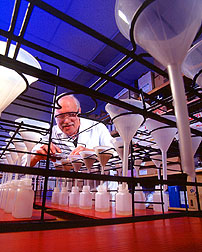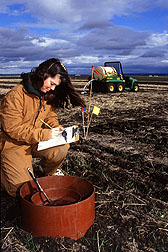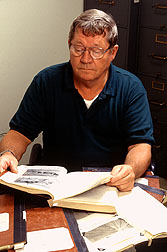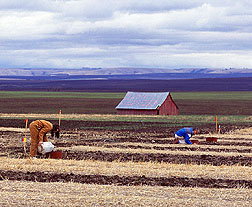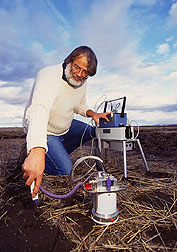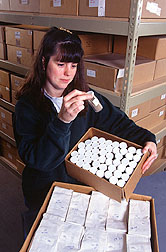Farmland Studies for the Long Haul
Hot, dry, and windy. That description might not bring Oregon to mind. But some parts of the Columbia Plateau on the eastern side of Oregon's Cascade Range receive less than 10 inches of precipitation annually--compared with 60 inches on the verdant western side of the slopes and nearly 200 inches in the coastal mountains.
The soil in this dry region of the Northeast is among the most fertile in the nation. It was left behind by glaciers, then swirled by wind and redeposited up to 150 feet thick. The plateau rings an ancient lake bed stretching from the Cascades east to Idaho, and from northeastern Oregon to Canada.
The area produces the lion's share of the nation's soft white wheat crop, worth more than $1 billion annually. Soft white wheat is preferred for Asian noodles and confections.
To help wheat growers stay competitive in the future, scientists are looking to the past.
The Columbia Plateau Conservation Research Center in Pendleton, Oregon, manages some of the longest running agricultural experiments on cultivated land in the western United States. The center is managed cooperatively by the Agricultural Research Service and Oregon State University.
|
|
Settlers first began farming here in the late 1870s. By the early 1900s, lower yields and erosion were already problems. The Pendleton experiment station was established in 1928 to provide practical solutions.
Wheat planted in October takes advantage of winter rain and snow. From April until the August harvest, the crop relies mostly on water stored in the soil. Even so, many areas are too dry to support a crop every year. To conserve water, the standard practice has been to grow wheat 1 year and leave the land unplanted, or fallow, the next.
But this causes other problems. With rain and melting snow on frozen soil--and slopes greater than 25 percent in some areas--the region has some of the country's worst erosion problems. And one of the most important measures of soil quality--soil organic matter--has declined up to 40 percent since farming started.
Taking a Long View
Experiments set up in 1931 help chronicle the history of farming in this region and now give scientists a unique resource for setting the best future course.
"These research plots give us a baseline for comparison that we could achieve in no other way," says ARS soil scientist Paul E. Rasmussen. "And studies to identify sustainable management practices and potential climate changes have created international interest in the experiments," he says. Rasmussen served as chair of the committee that oversees the experiments until 1997. He retired in early 1999 but still collaborates with the lab.
|
|
The Pendleton experiments include:
- Grass Pasture: This 150- by 360-foot plot was taken out of crop production in 1931 and represents lightly grazed grassland.
- Continuous Cereal: Three adjacent plots have been planted with cereal grains every year since 1931 as a comparison for other crop rotations. The crops grown have changed over the years and now include winter wheat, spring barley, and spring wheat. The soil is conventionally —tilled with a moldboard plow.
- Residue Management: This experiment represents the typical farming techniques used in the region. In this block of plots, winter wheat has been alternated with fallow since 1931. Nine 38- by 132-foot plots receive different treatments, such as burning the wheat stubble in the fall, burning in the spring, or applying different amounts and types of nitrogen. All are conventionally tilled.
- Tillage-Fertility: Established in 1940, this experiment is also winter wheat/fallow, but it compares different types of tillage, including moldboard plow, chisel plow, and sweep tillage. Nitrogen applications also vary.
- Wheat/Pea: Since 1963, winter wheat has been alternated with a pea crop in this experiment to determine the viability and nitrogen needs of a wheat/legume rotation. These plots use four different tillage systems.
|
|
- No-Till Wheat: This experiment, set up in 1982, analyzes wheat yield and soil quality in a no-till winter wheat/fallow system. In 1997, an identical set of plots was set up so that scientists could see how the soil and crop variables change when land is converted from conventional tillage to no-till--also called direct seeding.
What the Research Tells Us
Data collected over 6 decades show that grain yield has nearly doubled since the 1930s, thanks to improvements in wheat varieties and soil fertility management.
The traditional farming system included fallowing every other year and tilling with a moldboard plow. But the experiments showed that the long-term environmental costs of these practices is high.
The system leaves the land vulnerable to wind and water erosion that carry away the nutrient-rich soil and require farmers to add increasing amounts of nitrogen fertilizer. In fact, the same varieties that provide higher yields need much more nitrogen. Wheat crops in the 1940s used 15 pounds of nitrogen per acre; by the 1980s, they required 80 pounds.
Adding ammonium-based fertilizer also causes problems, such as increased soil acidity, which requires yet another additive--lime--to raise the soil's pH. This added cost puts even more pressure on farmers struggling to survive when wheat prices are low.
Part of the answer is to retain or improve soil organic matter. Organic matter represents the part of the soil formed by decomposition of carbon-based life: mostly plants and microscopic organisms. The rest of the soil is made up of sand, silt, and clay. Without added inorganic fertilizers, plants derive most of their nutrients, including nitrogen and sulfur, from the organic matter.
"When farmers started growing wheat on the Columbia Plateau, they didn't realize the importance of soil organic matter," says ARS microbiologist Steve L. Albrecht, who now manages the ARS conservation studies. "These experiments are showing us the best methods to evaluate and maintain soil quality."
Farmers and scientists have known for years that leaving the straw residue from the previous crop on the surface reduces erosion by holding the soil in place. The long-term no-till experiment has shown that seeding directly into this residue without tilling also helps improve soil quality over time.
But previous attempts at no-till direct seeding largely failed because weeds were harder to control, wheat diseases were severe, and capital costs for new equipment were high.
"Farmers didn't know what to expect when they tried to convert to no-till, and many were unsuccessful," says Albrecht. But environmental conditions and rising production costs are forcing the issue, creating renewed interest in no-till.
"We've shown that water infiltration and earthworm activity increase dramatically soon after switching to no-till," he says. "That reduces erosion and increases water availability to crops."
Soil organic matter also increases--but very slowly, over long periods of time.
What's New at Pendleton
|
|
The newest experiment duplicates the no-till plot established in 1982. The scientists' goal is to precisely monitor changes to soil quality and other crop variables as a field is converted from conventional tillage to direct seeding. "That way, farmers won't have any surprises," Albrecht says.
The experiments have also been included in several international studies, many of even longer duration.
"The nonirrigated, semiarid nature of the Columbia Plateau mirrors other areas of the world that have no such experiments," says Rasmussen. "So even though the experiments aren't as long-term as some, they appeal to researchers looking at global trends."
Most of the current team of Pendleton scientists, as well as many retired ARS and university scientists, have worked on the plots since their inception. But much of the credit for their ongoing success and international reputation goes to ARS' Rasmussen.
When he arrived in 1971, he quickly became interested in the long-term research, but he realized that many of the records were in disarray.
"The long-term plots were well maintained, but not much analysis had been done," says Rasmussen.
OSU plant pathologist Richard W. Smiley, superintendent of the station, agrees. "For many years, funding sources wanted to focus on research with more immediate benefits. That drew many scientists away from the longer term projects," he says.
|
|
The emphasis on short-term research worried Rasmussen.
"The conclusion you reach in the short term may not be appropriate over a longer period of time," he says. "When you drastically change a farming system, it takes time to reach a new equilibrium. If you only take a snapshot look at a changing system, the view could be completely different from what it will look like when it stabilizes."
Rasmussen assumed the task of organizing the data and trying to fill in the gaps. Although this project was not within his assigned scope of investigation, he devoted months of nights and weekends to this effort until it became an official part of his job.
Since then, he's set up a committee to oversee the experiments. The goal is to make changes necessary to meet the needs of the research and farming community while ensuring that the value of the data is not compromised.
"It's hard to say what the future of the experiments would have been if Paul hadn't taken an interest," says Smiley. "He was the right person at the right time to keep those experiments moving forward." — By Kathryn Barry Stelljes, Agricultural Research Service Information Staff.
This research is part of Soil Resource Assessment and Management, an ARS National Program described on the World Wide Web at http://www.nps.ars.usda.gov/programs/202s2.htm.
Steve L. Albrecht is at the USDA-ARS Columbia Plateau Conservation Research Center, P.O. Box 370, Pendleton, OR 97801-0370; phone (541) 278-4392, fax (541) 278-4372.
"Farmland Studies for the Long Haul" was published in the February 1999 issue of Agricultural Research magazine.
Just Off Press
A new, 32-page ARS publication, Low-Input On-Farm Composting of Grass Straw Residue (No. ARS-142), by Donald B. Churchill, W.R. Horwath, L.F. Elliott, and D.M. Bilsland, explains the effects that various composting procedures have on reducing straw volume. These procedures provide a necessary alternative to open field burning, which is being phased out in many regions through legislative mandates. The publication is available free of charge (while supplies last) from Donald Churchill, USDA-ARS, National Forage Seed Production Research Center, 3450 S.W. Campus Way, Corvallis, OR 97331-7102.







